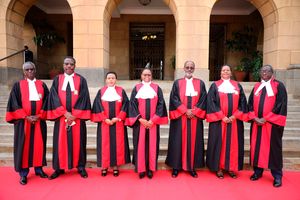Premium
CS Yatani moves to cut expenditure, increase revenue

The budget briefcase. DENNIS ONSONGO | NATION
Finance Cabinet Secretary Ukur Yatani has made bold budget cuts in efforts to force the government to live within its means.
In his first budget, the Cabinet secretary appears to have reversed the trend of avaricious expenditure after he cut total spending for the first time in five years.
Mr Yatani reveals in the 2020 budget policy statement that he intends to present a Sh2.7 trillion budget for the financial year that begins in July. This is a reduction of more than Sh120 billion.
The statement sets out the broad strategic priorities and policy goals that guide the national and county governments in preparing their budgets for the financial year and over the medium term.
The 2020 statement is the document that outlines the basis for the 2020/21 budget.
NOT SMALL
However, Sh2.7 trillion is still not a small figure going by the East African standards and the ambitious revenue targets he has given the Kenya Revenue Authority.
With Sh2.7 trillion, the country can build the Mombasa-Nairobi standard gauge railway eight times.
With this kind of money, Kenya can construct at least 85 Thika superhighways and still be left with change.
If it were to be divided equally among the 47.5 million Kenyans, every citizen would walk away with at least Sh57,000.
Mr Yatani projects that the taxman can be pushed to collect an extra Sh89.8 billion in the 2020/21 financial year, raising the tax target from the current Sh1.76 trillion to Sh1.85 trillion.
DEBT REPAYMENT
However, he proposes to direct the additional amounts to the Consolidated Fund Services (CFS), specifically debt repayment, pensions and gratuities and salaries for constitutional offices and independent commissions.
“These are non-discretionary expenditures which take first charge in the public budget,” he says in the document.
From the extra collections, some Sh57.2 billion will be earmarked for debt repayment – which will swell from the current Sh572 billion to Sh630 billion.
Treasury says revenue growth will not be adequate to cover shortfalls in the debt repayment kitty and that it will be supplemented with part of the savings from the government net issues. These savings will, however, not fully translate to the total budget, given that whatever he saved has been swallowed up by the growing debt.
The CFS – comprising domestic interest, foreign interest and pension – was the fastest growing line item, increasing from 19.1 per cent of the total budget to 21.1 per cent.
FIX ECONOMY
Seen as the last finance chief who will shoulder the burden of fixing the economy, Mr Yatani inherited a docket that was dangerously addicted to debt.
However, his budget still lacks expenditure signals geared at fixing and rejuvenating the economy, akin to the stimulus package under the President Mwai Kibaki administration, which was a deliberate effort to put money in the pockets of ordinary people.
The three arms of the government will consume Sh1.8 trillion, which is the lion’s share of the budget. The Executive will be given Sh1.7 trillion, Parliament Sh36.2 billion and the Judiciary has been allowed a ceiling of Sh18 billion.
The three arms will have to contend with lower amounts compared to what they currently have.
BUDGET REDUCTION
The Executive, for instance, will see its budget reduce by about Sh174 billion.
The Judiciary should expect a Sh1.2 billion cut while the Legislature will see its expenditure squeezed by about Sh3.6 billion.
The CS still managed to cut the total budget by about Sh150 billion, a significant departure from his predecessors who presented expansionary budgets every year that put the country in a debt distress corner.
Total recurrent expenditure for the government will be capped at Sh1.7 trillion, while development will take up Sh587 billion.
This means that unless the government borrows, it will be unable to do any development despite collecting Sh2.1 trillion in taxes.
Counties should also brace themselves for tough times after the Treasury allocated them Sh375 billion.
The allocation in the current year was Sh378.3 billion.
Of this amount, some Sh316.5 billion will be shareable revenue.
Conditional allocations to counties will total Sh58.5 billion while level-five hospitals will get Sh4.6 billion.
RECEIVE BILLIONS
The Equalisation Fund account will receive Sh6.5 billion.
Generating Sh2.1 in revenues will leave a gap of Sh614 billion, which Treasury plans to fill through borrowing and grants.
Treasury will borrow Sh571.2 billion. Domestic borrowing is projected at Sh222.9 billion while the foreign debt market is expected to lend Kenya Sh345.1 billion.
Grants are expected to contribute the remaining Sh42.8 billion.
FOREIGN SOURCES
The net borrowing is expected to be Sh571.2 billion, out of which Sh345.1 billion will come from foreign sources while Sh222.9 billion will be domestic.
At Sh571.2 billion, Mr Yatani would have reduced the net borrowing by Sh70 billion from the budgeted Sh641 billion.
The minister expects the KRA to collect Sh1.8 trillion as ordinary revenue from taxpayers.
The taxman has been made to set an ambitious target of Sh862.3 billion from income tax.
COMPANY PROFITS
This tax refers to the money collected from salaries and wages as well as profits made by companies.
The second most important revenue stream will be Value Added Tax, which is expected to contribute Sh496.4 billion. Excise and import duty will contribute Sh258 billion and Sh126.5 billion respectively.
The rest of the money will come from investment income (Sh21 billion) and railway development levy (Sh27.8 billion), while ministries will be expected to generate Sh249.6 billion.
Treasury also expects other income amounting to Sh92.5 billion.
Salaries will remain the biggest consumer of taxes.
***

A farmer attempts to scare desert locusts from his farm in Masaku, Machakos. JOSEPH KANYI | NATION
Treasury: Kenya’s economic outlook is grim
The locust invasion, a growing wage bill, high oil prices and climate change could hurt Kenya’s economic outlook, the National Treasury has said.
In his first budget policy statement, Treasury CS Ukur Yatani said the macroeconomic outlook faces internal and external risks.
“Risks from global economies relate to rising oil prices due to tensions between the US and Iran, uncertainty of the trade agreement between Britain and the EU as well as uneven and sluggish growth in advanced and emerging economies,” the statement says.
The document adds that low commodity prices and the risk of energy prices increasing could have a negative impact on Kenya’s exports.
RISK EXPOSURE
Treasury expects the economy to be exposed to risks arising from public expenditure and the inevitable climate change and variability, which has led to an increase in the frequency of disasters such as landslides and drought.
In addition, the locust invasion poses a risk to agriculture.
“These shocks are likely to have an impact on energy generation and agricultural output, leading to higher inflation that could slow down growth,” the paper says.
The budget is usually framed using assumptions and expectations on performance.
MACROECONOMIC STABILITY
Treasury says the government continually monitors these risks to ensure macroeconomic stability and strengthen resilience in the economy.
“To cushion the country against these risks, the government is deepening reforms in the financial sector,” it adds.
Treasury says it is also safeguarding macroeconomic stability through prudent fiscal and monetary policies.
In particular, it adds, the government continues to accumulate forex reserves to deal with external shocks.
“The ongoing enhanced domestic resource mobilisation and expenditure rationalisation will reduce wage-related pressures and debt accumulation, creating fiscal space necessary for economic sustainability,” the document adds.





